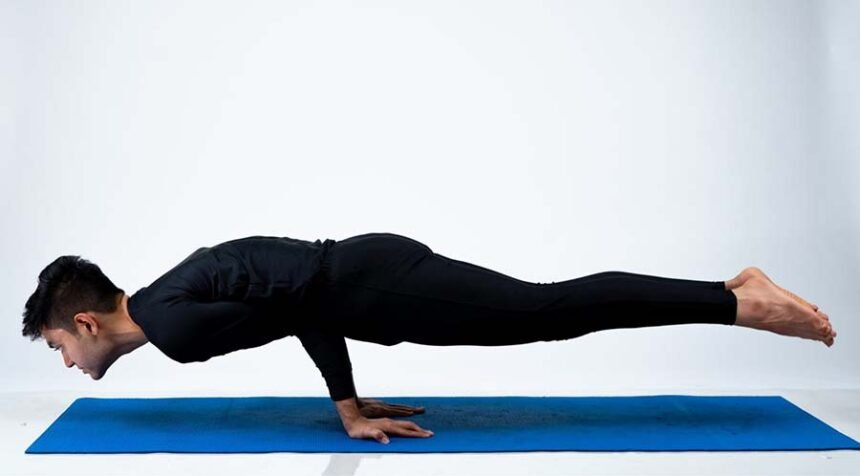Mayurasana, or Peacock Pose, is a powerful and challenging yoga posture that embodies strength, balance, and grace. Named after the peacock, a bird known for its vibrant beauty and ability to digest toxins, this arm-balancing pose is revered in yoga for its physical and mental benefits. While it requires practice and core strength, Mayurasana offers profound advantages for the body and mind, particularly in improving digestion, building strength, and enhancing focus. In this blog, we’ll explore what Mayurasana is, how to perform it safely, its benefits, and tips for beginners.
What Is Mayurasana?
Mayurasana is an advanced yoga pose where the practitioner balances on their hands with the body lifted parallel to the ground, resembling a peacock with its tail feathers spread. The pose engages the core, arms, and wrists while stimulating the digestive system, which is why it’s associated with the peacock’s ability to neutralize toxins. Traditionally part of Hatha yoga, Mayurasana is both a physical and energetic practice that strengthens the body and promotes detoxification.
Key Characteristics:
- Type: Arm-balancing pose
- Level: Advanced
- Sanskrit Meaning: “Mayura” (peacock) + “Asana” (pose)
- Primary Focus: Core strength, balance, and digestion
Due to its intensity, Mayurasana is best practiced under the guidance of an experienced yoga instructor, especially for beginners or those with health concerns.
How to Perform Mayurasana (Peacock Pose)


Before attempting Mayurasana, warm up with poses like Downward-Facing Dog, Plank, and Chaturanga to prepare your core, arms, and wrists. Use a yoga mat for grip and comfort.
Step-by-Step Instructions:
- Starting Position: Kneel on the floor with knees slightly apart.
- Hand Placement: Place your palms on the ground, fingers pointing toward your feet (backward). Keep your hands close together, with fingers touching or slightly spread.
- Elbow Positioning: Bend your elbows and rest them against your lower abdomen, just below your navel. The elbows should press into your core to act as a fulcrum for balance.
- Engage Core: Lean forward slightly, engaging your core muscles to prepare for lifting.
- Lift the Body: Shift your weight onto your hands and elbows, slowly raising your legs and head off the ground. Keep your body parallel to the floor, with legs extended back and toes pointed.
- Balance and Hold: Straighten your legs and keep your gaze forward to maintain balance. Hold the pose for 10–30 seconds, breathing steadily.
- Release: Slowly lower your legs and head back to the ground, then release your elbows and return to a kneeling position.
Modifications for Beginners:
- Place a block under your feet to assist with lifting.
- Practice with your knees bent and feet tucked under to reduce the weight load.
- Use a wall for support by resting your feet against it while learning to balance.
Precautions:
- Avoid Mayurasana if you have wrist, elbow, or shoulder injuries, heart conditions, high blood pressure, or digestive issues like ulcers.
- Pregnant women or those with recent abdominal surgery should not attempt this pose.
- Stop immediately if you feel pain or discomfort in your wrists or abdomen.


Benefits of Mayurasana (Peacock Pose)
Mayurasana offers a wide range of physical, mental, and energetic benefits, making it a transformative addition to a yoga practice.
Physical Benefits
- Strengthens Core Muscles: The pose intensely engages the abdominal muscles, building core strength and stability.
- Tones Arms and Shoulders: Balancing on the hands strengthens the wrists, forearms, and shoulders, improving upper body endurance.
- Improves Digestion: The pressure of the elbows on the abdomen stimulates digestive organs, aiding in detoxification and relieving issues like constipation or bloating.
- Enhances Circulation: The pose promotes blood flow to the upper body and digestive system, supporting overall vitality.
- Boosts Balance and Coordination: Holding Mayurasana requires focus and precise muscle engagement, improving balance and body awareness.
- Stimulates Abdominal Organs: The pose massages internal organs like the liver, pancreas, and intestines, potentially improving metabolism and detoxification.
Mental Benefits
- Enhances Focus and Concentration: Balancing in Mayurasana demands mental clarity and focus, calming the mind and reducing distractions.
- Builds Confidence: Mastering this challenging pose fosters a sense of accomplishment and self-assurance.
- Reduces Stress: The mindful breathing and concentration required in Mayurasana promote relaxation and mental clarity.
Energetic Benefits
- Activates Manipura Chakra: Mayurasana stimulates the solar plexus chakra (Manipura), associated with personal power, confidence, and energy.
- Promotes Detoxification: According to yogic philosophy, the pose helps eliminate physical and energetic toxins, fostering balance and vitality.
Tips for Practicing Mayurasana Safely
- Warm Up Thoroughly: Prepare your body with wrist stretches, core exercises, and poses like Plank or Boat Pose to activate the necessary muscles.
- Use Props: Blocks, straps, or a wall can make the pose more accessible while building strength.
- Practice Gradually: Start with preparatory poses like Chaturanga or Crow Pose to develop arm and core strength before attempting Mayurasana.
- Engage a Spotter or Instructor: For beginners, having a teacher or partner nearby ensures safety and proper alignment.
- Listen to Your Body: Avoid forcing the pose, as it can strain wrists or the abdomen if done incorrectly.
- Practice on an Empty Stomach: Since Mayurasana stimulates the digestive system, perform it at least 3–4 hours after eating.
Complementary Practices
To enhance the benefits of Mayurasana, incorporate these practices:
- Core-Strengthening Poses: Plank, Boat Pose (Navasana), and Side Plank build the strength needed for Mayurasana.
- Wrist Stretches: Gentle wrist rotations and stretches prevent strain and improve flexibility.
- Breathwork (Pranayama): Practice deep belly breathing or Kapalabhati to support digestion and mental focus.
- Restorative Poses: Follow Mayurasana with Child’s Pose or Savasana to relax the body and integrate the benefits.
When to Avoid Mayurasana
Consult a doctor or yoga instructor before attempting Mayurasana if you have:
- Wrist, elbow, or shoulder injuries
- High blood pressure or heart conditions
- Hernia, ulcers, or other abdominal issues
- Pregnancy or recent surgery
- Chronic pain or mobility limitations
Conclusion
Mayurasana, or Peacock Pose, is a dynamic and empowering yoga posture that strengthens the body, sharpens the mind, and supports digestive health. While it’s an advanced pose requiring practice and patience, its benefits—ranging from improved core strength and digestion to enhanced focus and confidence—make it a rewarding addition to a yoga practice. Approach Mayurasana with mindfulness, proper preparation, and guidance to unlock its full potential safely. Whether you’re a seasoned yogi or an aspiring practitioner, the Peacock Pose can inspire you to soar to new heights in your yoga journey. Namaste!


